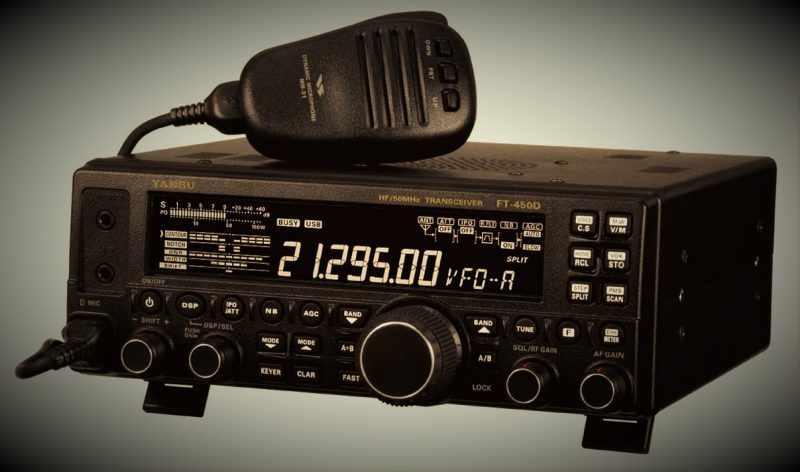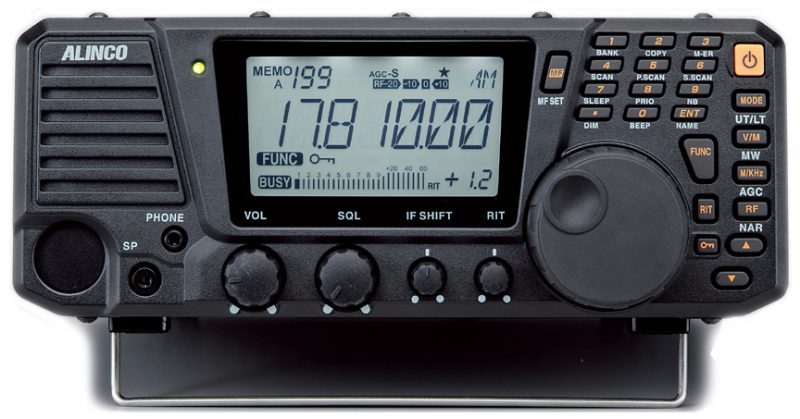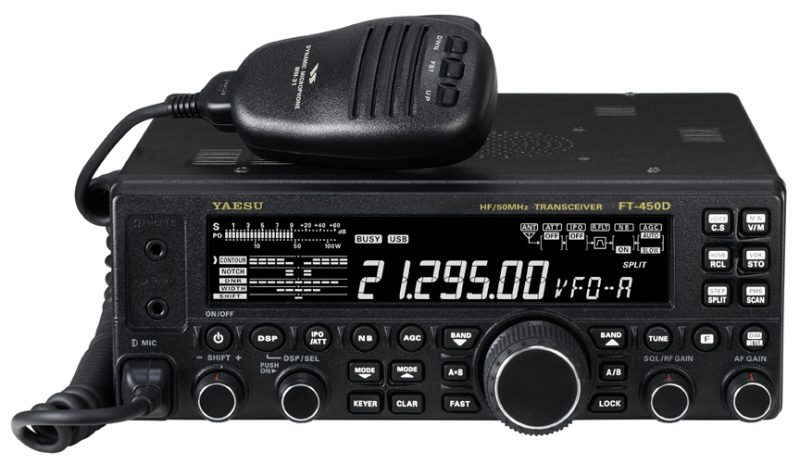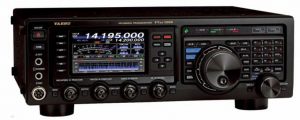 No doubt, the Covid-19 global pandemic has had a mostly negative impact on our daily lives.
No doubt, the Covid-19 global pandemic has had a mostly negative impact on our daily lives.
Surprisingly, I found that the impact on the amateur radio world, at first, was quite minimal. Not only did sheltering at home seem to increase the number of operators on the air, but I found that most of the radio items I needed to purchase were largely available.
Since mid-May, however, radio retailers have struggled to maintain inventory on certain items mainly due to shipping issues from manufacturers (especially when international shipping was involved). Covid-19 issues have also delayed the introduction of a number of transceivers and portable shortwave radios we should have seen in production already.
Most recently, however, I learned from a trusted source that Covid-19 has lead to the early demise of at least two popular radio models.
Alinco DX-R8T: Discontinued
 The Alinco DX-R8T has enjoyed a long product life. I recall reviewing this fine tabletop receiver back in 2011. It has been a very popular radio because it’s been one of the only “legacy” tabletop receivers still in production.
The Alinco DX-R8T has enjoyed a long product life. I recall reviewing this fine tabletop receiver back in 2011. It has been a very popular radio because it’s been one of the only “legacy” tabletop receivers still in production.
I recently learned that Alinco will no longer produce the DX-R8T due to “parts issues.” One would have to assume that this will also affect the DX-R8E (EU version) and eventually the DX-SR8T which is the transceiver version of this model.
Retailers may still have some inventory of these models, but once those models have been purchased, there will be no more. I would certainly suggest purchasing the DX-SR8T transceiver as an alternative since the price difference is modest and it’s built on the same receiver as the DX-R8T.
Yaesu FT-450D: Discontinued
Like the Alinco above, Yaesu has announced that they are discontinuing production of the popular Yaesu FT-450D general coverage transceiver due to “parts issues.”
It’s worth noting the venerable Yaesu FT-DX1200 recently met the same fate.
To be clear: parts obsolescence happens in the best of times. Covid-19 has simply accelerated the issue.
If you’ve been considering the purchase of one of these models, you might bite the bullet now if you can find a retailer with inventory.
If I learn of any other radios being discontinued, I’ll publish updates here on the SWLing Post.



The Chinese are nipping at the heels of the Japanese manufacturers… and for $425 the Xeigu G90 SDR xciever fits well with many features not found on other rigs. I have one, and you can easily ‘work the world’ on 20 watts into an EFHW or UNUN antenna.
Things are changing fast in the amateur and SWL worlds. So unless your into satellite or VHF/UHF ssb the demise of the FT 857 shouldn’t be a big deal… my new FT 891 replacement @ 100 watts and with 6 meters will do me just fine for the $639 I paid for it. (Unfortunately) It can easily be opened up to operate on the 27mhz chicken band… Picking it up at HRO next week.
I don’t care aboit bells and whistles. I prefer the plain Jane with the least amount of lights and buttons. The Kenwood TS-480SAT had more than I wanted nut at least I could afford it on my gimpy income…(SSDI) My 4 year old Grandson could goof me up and it’d take me hours to figure out what button he pushed! Guys, I’m only using 10 and 6 meters and I can’t dole out stacks of Cabbage big enough to ckoke a Mule. These Manufacturer’s just gave me the worst kick in the teeth I’ve ever experienced. They’re FORCING me to look at Chinese imposter equipment. I was a volunteer firefighter and so appreciated by our Government, I get to live on LESS than $1,000.00 per month. I’ll die before I ask my wife for one red cent. What are these companies thinking? Are they wanting this to be an rich man’s only hobby? Model Railroading went sideways 50 years ago so I suppose this van too. $200.00 and up for a Locomotive for a 4 year old to play with. Pfft!
Why do you think it’s a COVID-19 issue? Parts go obsolete all the time.
You’re correct: parts go obsolete all the time. Covid-19 has just hastened this because the original parts manufacturer has made their own cuts in light of decreased production and their own supply chain issues. It’s sort of a cascade effect that takes a toll on certain components (not all). Yaesu may have been able to compensate for this with a re-design but just decided not to in the current environment. Or, perhaps, they just pulled the plug a bit earlier than they had planned. It’s tough right now on manufacturers that were within a couple of months of releasing products when C-19 hit.
I believe it.
I need to be vague here for obvious reasons, but I work for a company that makes monitoring devices. Our most popular product is in jeopardy now and we’ll likely have to do a MAJOR redesign when we don’t want to because of two key components that we purchase from other manufacturers that have recently become obsolete. Other than the fact it has some wireless tech built into it, it’s not ‘a radio device’. While we are a reliable customer of both of these companies, both manufacturers have had to cut production to accommodate social distancing in the plant and both were completely closed for nearly two months. They’re trying to catch up to focus on their most popular components. It’s not that they can’t physically still make the part, it’s that they don’t have the capacity to make our parts which are smaller runs for them and require re-tooling. While it’s possible they may begin production on these again in a year or two when things are back to normal and they’re running at full capacity, we can’t wait. Our distributors are running out of inventory. It’s created a huge headache for me because changing out one of the components will 100% require an enclosure redesign. We’re even having difficulty locating replacement components that we can feel confident the supplier can promise in quantity right now with acceptable lead times.
I may be jaded. OK I am jaded. But this is a very difficult year for companies that produce technology. I bet we’ll see more models bite the dust prematurely this year.
Wow, Jim. I hope you can sort our replacement parts soon. Perhaps things will normalize sooner than we anticipate.
Cheers,
Thomas
I want to be hopeful, but by all indications this is a problem that will persist maybe a year or more. Funny part is for companies like us it’s striking our most popular products. Not a lack of demand…in fact healthy demand. We just don’t have all of the parts to make new products. Frustrating.
To end on an optimistic note this will give us an opportunity to make a couple of iterative upgrades that have been on the back burner. If we can just pivot now during a redesign and keep our furloughed staff from going elsewhere. Looking forward to 2020 being in the rear view mirror as they say.
I think we’re all looking forward to 2020 being the in the rear-view mirror, Jim! 🙂 Godspeed, buddy!
That’s why I have a lot of tube rigs in addition to my solid state rigs.
When one of the obsolete chips fails, those rigs are reduced to a brick.
The tub rigs are easily serviceable and will live on far beyond most solid state rigs.
I know that the Icom ID-51A+2 and ID-31A+ D-star HT’s have been discontinued. Have read that it was a parts issue. And I have not seen any info on replacement radios.
When I saw the first Toyota Prius, I instantly recognized that this was a paradigm shift, and that all of the other car manufacturers should (and would) eventually be making hybrids. I don’t see how it’s any different with radio, now that SDR design is here and superior in every way to “conventional” design: Software costs a LOT LESS than hardware. And in the middle of production, you don’t have some third party parts manufacturer throwing a Monkey Wrench into the works because “suddenly” they don’t make a certain part.
What I see: The “Big Three” (YIK) will all be offering SDR radios. The Icom 7300 is akin in this Paradigm Shift to the Toyota Prius, and any manufacturer who thinks differently is just kidding himself. And Japanese Branded radios made in China will be facing stiff competition from Chinese manufacturers, as soon as the Chinese figure out how to retail directly. And they WILL. It’s already beginning to happen, and it’s no different than when the primarily American Brands were trumped (you should excuse the pun) by the Japanese brands that we know today. We will also see SDR level the playing field with offerings from other shores, AND right here from home!
My question is, what replaces these in the manufacturer’s lineups? Yaesu stopped production on the FT-857D several months ago (also due, I suspect, to ‘parts issues’). Both the 857D and the 450D were strong sellers, particularly the 857D. Compact mobile HF rigs are Yaesu’s forte. I have to think that Yaesu has something waiting in the wings. At least I HOPE they do.
The Yaesu FT-857D will be very sadly missed. It’s probably been the most popular mobile form-factor “DC to daylight” all-mode 100W radio worldwide for many years. The suposed replacement FT-891 does not cover 2m and 70cm.
The hobby is struggling for relevance in a changing world. As well, newer advanced models like the upcoming 705 from icon is offering considerable value necessitating these other companies to meet that challenge. I suspect Yaesu will introduce a better 817 or 818, like they should have done first time around. Icom is meeting the changing world by upping the game not running away from it.
PARTS will be an issue through the industry and even for we who home brew our own types of communications devises. It’s a PERFECT STORM.
Agreed.
The end of our love for radio coms mostly caused by the Chinese virus..covid 19. Since computers came along it’s taken the shine away from our once loved communications over the airwaves.But now with the Covid 19 this has gone against our love for radio with many products and equipment not available anymore.Very disheartening to many of us who have the passion for what we do.
This is just a normal part of the way modern equipment becomes obsolete. You try getting a Kenwood TS850 repaired if some of its’ bespoke chips have failed. Buy a vintage radio, pre 1980s, and it will last you a life. It will also keep technicians in work keeping it in tip top condition. I saw this debacle coming in about 1982, swl and ham equipment becoming more complex and at the same time more throw away. The latest feature full radio is only in fashion for a short time until a more feature full model is introduced.
Considering the production cycles of many semiconductor parts, “parts issues” are quite frequent. Surely, the equipment manufacturers could buy some stock in time. But this measure binds capital that also costs money. And what do you do with “old stock new parts” if the demand for the final product disappears?
If you compare for example the technical data of the different models of Yaesu FT-817/818, you find very few arguments to switch to a newer version. Whether you have 5 W or 6 W of RF output is definitely no issue. Otherwise not much changed at the technical data. So why to a re-design? “Parts issues”, what else?
If Yaesu had provided the option for the FT-818 to replace the internal battery by a simply to integrate computer with a Raspberry Pi form factor, things would have looked quite differently.
Is it really a “parts” issue or are the big manufacturers simply vacating the low cost end to focus on high price items and leave the rest to smaller firms. You see them popping up everywhere and from many countries.
The retailers I spoke with told me these were very popular models with solid, steady sales–in other words, “cash cow” models. With all of the competition, as you mention, for lower-priced transceivers, I don’t think it would be a wise strategy to abandon more affordable models.
This is true. Very few of us can afford the 1800 and up range of equipment.
And frankly? These days some of the affordable stuff gives the $1800s and up a run for their money.